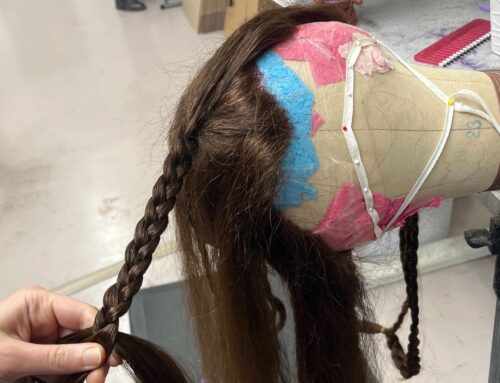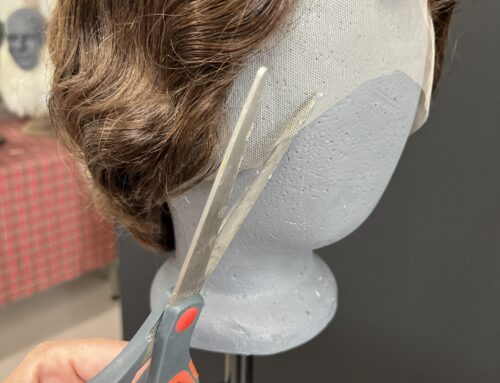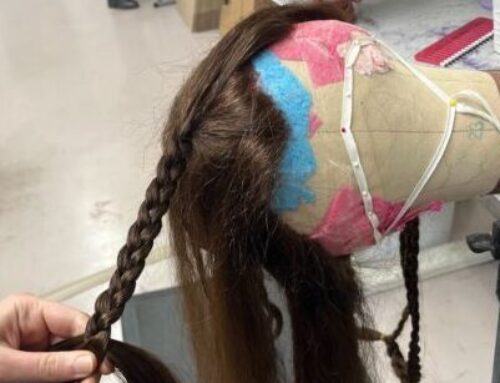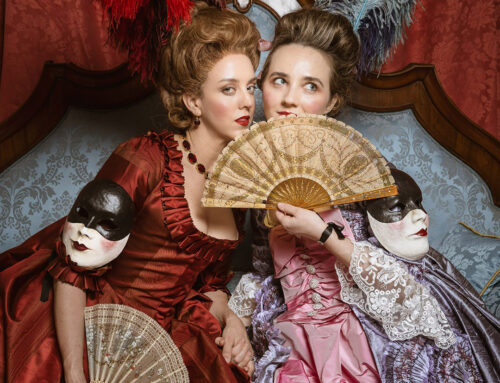Hello, everyone! Welcome to the second installment of our series on What About Wigs, where we’re detailing the different kinds of wigs, their uses and advantages/disadvantages for each. In Part One we talked about the four major different kinds of wigs, which I’ll recap below. In this piece we’re going to discuss the reasons to choose a specific kind of wig as well as the perks and drawbacks to those choices, as well as discussing the differences between synthetic and real hair.
To quickly summarize the first part, the four types are as follows:
1 – fashion wigs – machine made of wefted material stitched onto a (generally) stretchy cap.
2 – machine tied wigs – individual hairs tied onto a cap.
3 – lace-fronted wigs – same as type 2, or a mix of 1 and 2 with a lace front intended to blend into the forehead.
4 – custom made wigs – built to specification for the purchaser, hand ventilated and generally featuring a lace front. A variation of this kind is to replace the top and front of a cheaper wig with hand-made components.
Fashion and Machine-Tied Wigs
For the sake of this article, we’re going to lump these first two types together. These two types are both cheaper and easy to wear, making them great choices for costumes in which realism isn’t a necessity. Many cosplayers or one-off Halloween outfits can benefit from this kind of wig, and it’s easy to find styles to go with anything from anime characters to Lord of the Rings wizards. These wigs are also resilient enough to hold their style through multiple washes, as the synthetic hair used in their production is fused into shape.
There are higher end wigs of these varieties as well. Many machine-tied wigs are designed to be worn for everyday life, and are designed more for individuals with hair loss. They feature a more realistic look, and so are great for a natural appearance, or for costuming when realism is more of a concern. Machine-tied wigs are often harder to find as well, and are generally available through online retailers specializing in regular-wear wigs for those with hair loss.
Despite the perks of these sorts of wigs, they are still prone to issues. If you are going to be wearing the wig frequently and are concerned about washing and maintenance you might be in for a surprise – despite the fact that the wigs hold their shape, synthetic materials can be prone to frizzing, and once that happens the wig is irreparably damaged. Not only that, but if you buy one of these wigs in a particular style, then that’s the style you’re stuck with. This isn’t a problem if you’re looking for a wig to fill a niche role, but if you want something you can wear in a variety of styles you aren’t going to get it with one of these.
The bottom line with this kind is that you’ll get a wig for quick, cheap purposes. If you need something outlandish then you’ll be able to find it in this variety, and if you need a quick change of look that won’t be subject to much scrutiny this is your best bet. If you’re outfitting a stage production where a large number of identical styles are needed these are excellent as well.
Lace-Front Wigs (Machine Made)
These are a our next type – machine made, but fronted with lace in order to blend into the forehead. If you read the first half of this series, you may have noticed the photo comparing the different kinds of lace used for wig production. The thicker, heavier type is what these are made out of, and as a result you’re often left with a noticeably unnatural hairline. Despite this fact, the edge can be trimmed back so that the lace is well-hidden by the hairstyle and create a relatively realistic look.

The lace front of a machine-tied wig. This is generally cut back to hide the thicker lace.
These wigs are a bit more expensive than the previous two types, and are often geared towards wearers with hair loss. They are generally much better looking than the cheaper alternatives, and if worn correctly can present a hairline that is mostly invisible.
Lace-front wigs are available in a variety of styles and are well suited for street wear and stage productions. Despite the thicker lace, the edges are unnoticeable from a distance (i.e. – on stage) and are great for simulating modern hairstyles in a cheap but more realistic way.
Custom and Semi- Custom Wigs
These are the last and most expensive type of wigs available, as they are made completely to the individual wearer’s specifications and fit. Custom wigs are also often made with human hair, which is much more resilient to repeat wear and washing, and isn’t fused into a specific style, allowing for a variety of looks. Like the previous mentioned lace-front wig, these are fronted with transparent lace, but unlike the machine-produced variety the lace used in custom wig production is far thinner. While this can be beneficial for creating invisible hairlines, it also causes the wig to be a bit more fragile, and care needs to be used to make them last.
Custom wigs are an investment, but if you need the most realistic or specific look possible and have a larger budget, then these are the way to go. They are ideal for any situation where the wig will be viewed up close, as with practice the hairline can be applied to become practically invisible.
One of Custom Wig Company’s largest client groups is Santas, and they know that they are going to be up close and personal with people while wearing their set. Custom wigs are also ideal in any situation where realism in the paramount concern – since the cap is custom fit and the hairline is tailored to match the wearer, you’re assured the most realistic piece possible. Further, the hair used can be a variety of textures and variegation of color, further lending to the realism.
With these benefits comes a further risk of damage, however, and custom wigs can be delicate. This is offset by the fact that repair of a custom wig is often easier than a synthetic – human hair is more easily replaced, and the wig can be kept in excellent condition with just a bit of maintenance.
In short, if you’re looking for a cheap wig that will do the trick quickly and without much fuss, the fashion, machine-tied or lace-front wigs are the best bet for you. While these won’t hold up to as much scrutiny, a proper fit and wear will do the trick for street wear or stage performance. If you want something ultra-realistic, better fit or highly specific to a period look, custom or semi-custom is the best bet
Synthetic vs. Real Hair
While some synthetics can tend to look quite realistic, there is nothing that quite matches human hair for wigs. However, there are excellent reasons for choosing one over the other – just like a particular kind of wig.
Synthetic hair is cheaper than human, and while its texture isn’t as realistic there are continued improvements in its look – some synthetics even have pulverized human hair mixed in to enhance the look! Synthetics are also great at holding a particular style – once fused into shape they’ll hold it for a long time without much maintenance, even through washings. As I mentioned before, if the synthetic is damaged it’s as good as ruined, however, so care must be taken to ensure you don’t let the wig frizzed or tangled. Synthetic hair also washes easier, as it doesn’t swell like human hair. If a synthetic wig is stained or greasy it can be soaked, whereas a hand-knotted human hair wig could be destroyed if left to sit in water.
Synthetic hair is great for thick, voluminous looks – it’s much thicker than human hair and has much more volume, which unfortunately also equals weight and warmth as well. It’s excellent for use in styling a Georgian style wig, or something from the 1870’s or 1960’s.
Human hair is, obviously, far more realistic. It’s available in a wide variety of textures, allowing for any number of looks and styles. If you’re planning on wearing the wig often and/or long term, human hair is the best option. If you want a high-quality hairpiece to cover hair loss, then human hair is also an excellent bet, as it can be blended to match your hair color and texture, as well as presenting much less shine than synthetics. It’s more durable than synthetics as well, and can be repaired far more easily.
While human hair has its perks, it can be much harder to keep in a specific style. When not wearing a human hair wig, it’s a good plan to leave it in a net or curlers (for longer styles) to ensure it’s ready to wear next time you pull it out. Just like your hair, it’s much more prone to losing its shape in hot, humid weather. Moisture can also play havoc with a human hair wig, and as mentioned before, the strands will swell and possibly break if left to soak in water.
In brief, synthetic hair is great for quick, easy on wigs that require little care. They are also a bit less realistic, so are good for stage productions, those on a budget, or those needing really bulky styles.
Human hair is great for durability, versatility and realism. Just keep in mind that it isn’t as thick as synthetics and as such is better for softer styles that don’t need as much volume.





Leave A Comment